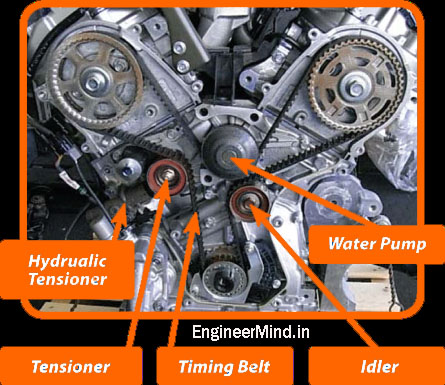What is the Timing Belt?
The timing belt is a very important part of the operation of the car’s engine. In the engine, there are two main shafts one is the Crankshaft, and another one is the Camshaft.
timing belt connect Crankshaft and camshaft and makes them turn together at the Same and Right time , its mechanism is similar to the way a bicycle chain connects the pedals to the back wheel.This makes sure all the other important parts (like valves and pistons) in the motor are jumping and hopping at just the right time.Hence the nam is ”timing Belt”.
Now Let’s Discuss
What Happens When It Breaks
The timing belt is made of rubber, if it breaks then your car stops. You have to take the car towed because it won’t start until the engine is “re-timed”, and the belt replaced.
in the interference type engine, the valve’s stroke and piston’s stroke take up the same space in the cylinder, so the timing belt essentially keeps them from smashing into each other, since they do it at different times. If the timing belt fracture, they run into each other, causing bent valves, cylinder head or camshaft damage, and possibly piston and cylinder wall damage. While it is possible that no damage could occur from a fractured belt on an interference engine, such a case is very less.
In a non-interference engine, the pistons and valves don’t occupy the same space, so if the timing belt snaps, no valve or cylinder damage occurs. You just pop a new belt on, and the engine should theoretically drive normally.
What You Have To Do
You have to do is replace the timing belt when it is due, instead of waiting until after it’s dead. The cost may be high, but it’s a whole lot cheaper than waiting for it to break.
The old standard interval for timing belt replacement was every 60,000 miles. Even if you don’t drive much, you should replace it every 6 to 8 years because age and dry rot will weaken it just as much as mileage and use.
What Should Be Checked, While Changing Timing Belt
Timing belt Tensioner
The timing belt tensioner is also sometimes faulty. They can be worn, or the bearings can be going bad. Many timing belt tensioners have a hydraulic tensioner which works with the tensioner bearing – but can also leak. If it “freezes up” on you, it will easily break the new belt.
If these things aren’t bad, we don’t mess with them, but if they are, it’s very wise to fix them at the same time you do the timing belt.
Water Pump
You have to take the timing belt off in order to get most water pumps off. A water pump has a little weep hole in it that the water comes out of when it goes bad. Even if it’s not dumping water at the time, sometimes there’s a trail of antifreeze or deposits from where it’s been coming out of that hole. If it shows signs of leaking, you can replace the pump while the timing belt’s off and save a lot of money over doing the jobs separately.
<style=”text-align: center;”>







